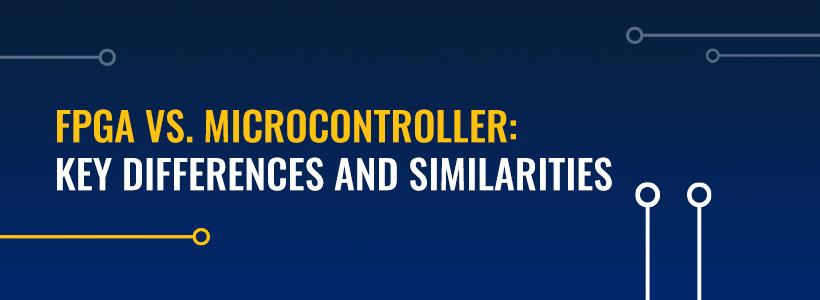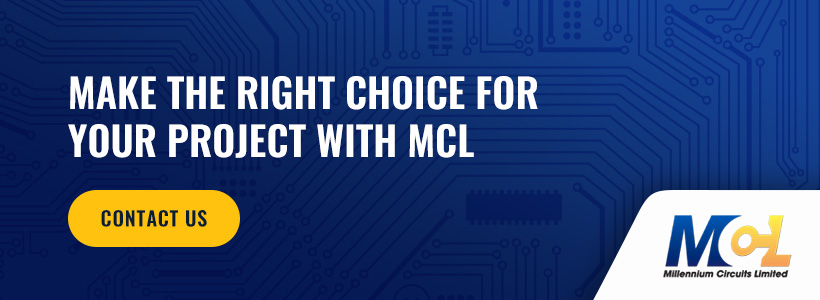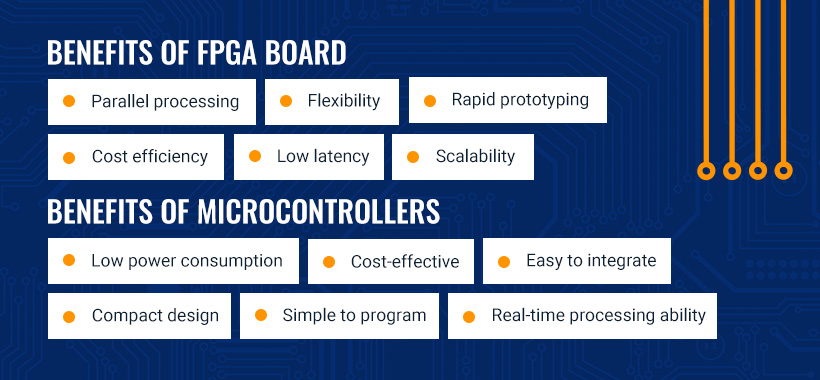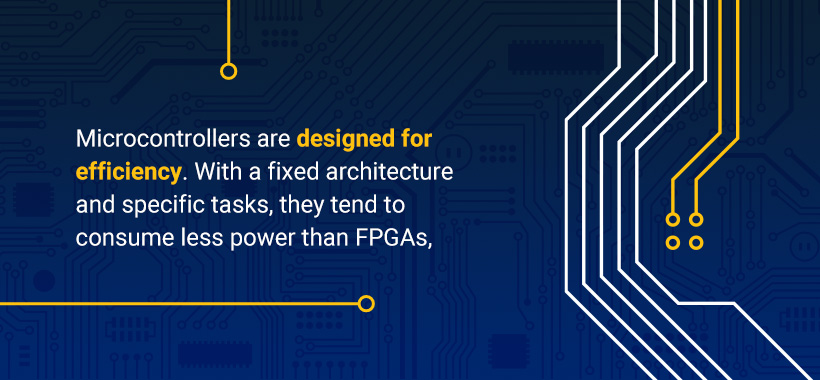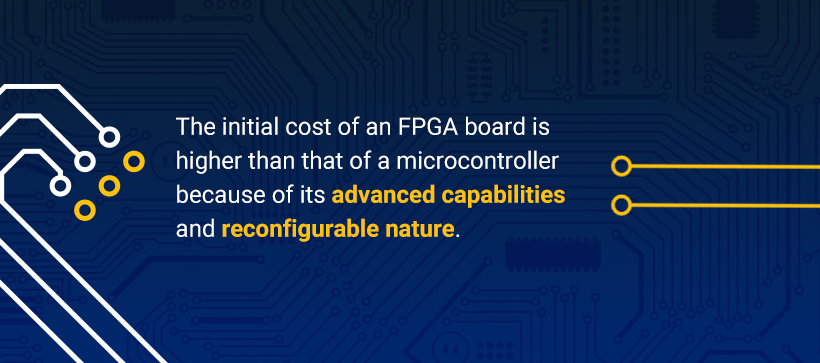Updated on January 15, 2025
Table of Contents
- What Is an FPGA?
- What Is a Microcontroller?
- FPGA vs. Microcontroller: Main Differences
- FPGA vs. MCU: Main Similarities
- Should You Use an FPGA or a Microcontroller in Your Printed Circuit Board?
Although a field programmable gate array (FPGA) and a microcontroller have similarities, they are not the same. FPGAs are known for their flexibility and ability to handle complex, high-performance tasks, while microcontrollers excel in efficiency and cost-effectiveness.
So, which one should you select? Choosing between these two options is not a matter of which is the “right choice.” Instead, you will want to consider how much flexibility and versatility you need, your budget constraints, and which makes the most sense for you and your project’s needs.
This detailed guide explores the similarities and differences between an FPGA and a microcontroller so that you can make an informed decision.
What Is an FPGA?
An FPGA is a type of computer chip that users program to perform specific tasks. This chip is “field-programmable” because it can be programmed “in the field” or after manufacturing. FPGAs are designed with HDL languages IEEE 1076 (VHDL) and IEEE 1364 (Verilog). Unlike regular processors with fixed functions, FPGAs are highly flexible and can be reconfigured to meet specific requirements without physically altering the hardware.
Most often, a chip comes preprogrammed, and as the user, you can change the software but not the hardware. With an FPGA, you can reconfigure its hardware after purchase. While a traditional processor’s architecture is fixed, the FPGA’s logic fabric can be changed at the gate level after deployment.
FPGAs can process multiple tasks simultaneously, making them ideal for demanding applications like artificial intelligence, aerospace, and telecommunications. Their ability to adapt and handle complex tasks like prototyping application-specific integrated circuits (ASIC) makes them a valuable tool for engineers. There are a variety of uses for FPGAs. For example, Intel uses a form of FPGA in its prototyping process.
Key Components
How does an FPGA work? Understanding the key components that enable its reconfigurable functionality will help you better understand FPGAs.
- Configurable logic block (CLB): A CLB is the core unit that gives FPGAs the ability to take on various hardware configurations. CLBs can be programmed to perform any logic operations. A CLB contains components such as look-up tables (LUTs) and flip-flops.
- Input/Output (IO) blocks: These blocks help manage the data flow between the FPGA and external devices. IO blocks ensure proper communication by handling essential components such as voltage level translation, timing adjustments, and signal conditioning.
- Digital signal processing (DSP) blocks: A DSP block is a specialized component in an FPGA used for digital signal processing functions like multiplying or filtering.
- Interconnects: A network of programmable wiring connects the CLBs and allows designers to define how the blocks should communicate. These are essential for creating complex circuits.
- Block Random Access Memory (BRAM): The BRAM is the dedicated memory on an FPGA chip. These blocks store data during processing and can support other functions, like error correction.
- Transceivers: These are made to transmit and receive individual bits of data to and from the FPGA at high speeds. They support protocols like HDMI, Ethernet, and Peripheral Component Interconnect Express (PCIe), ensuring reliable, high-performance connectivity.
Key Benefits
You can do many things with an FPGA board, making them a popular choice in many industries:
- Parallel processing: FPGAs can carry out multiple tasks simultaneously, speeding up operations that would otherwise be slower on sequential processors.
- Rapid prototyping: FPGAs’ reconfigurability allows for rapid prototyping, enabling quick design iterations without hardware redesign.
- Flexibility: Unlike traditional processors, FPGAs can be reprogrammed to suit specific needs. This can be ideal for projects where components need to be tailored as you go.
- Cost efficiency: Users can test various design iterations on a single platform, saving costs associated with creating and testing multiple prototypes.
- Low latency: FPGAs provide direct hardware-level processing, which can help minimize delays and ensure quick responses.
- Scalability: As project demands grow, FPGAs can be reconfigured or upgraded to suit the new project needs without having to order new hardware.
What Is a Microcontroller?
A microcontroller (MCU) is a simplified computer that runs one basic automated program repeatedly. It integrates a central processing unit (CPU), random-access memory (RAM), and input/output devices.
MCUs are entirely self-contained on a single chip. Unlike general-purpose microprocessors, microcontrollers run as one efficient stand-alone unit. Their ability to run as a single system makes them ideal for applications that need real-time signal processing. To be effective, microcontrollers work well when connected via printed circuit boards (PCBs) to other electronic circuits and components, as this combination can be used to control, monitor, and affect different systems.
You can find microcontrollers in everyday devices, such as:
- Keyboards
- Monitors
- Printers
- Copiers
- Fax machines
- Telephones
- Television remote controls
- Microwaves
- Washers and dryers
- Lawn sprinklers
- Children’s toys
- Traffic lights
- Car engine control systems
- Power tools
- Implantable medical devices
Key Components
How does a microcontroller work? There are three basic components involved:
- Central processing unit (CPU): This is the main component of a microcontroller and contains all core components, such as the program counter, arithmetic logic unit, register file, and more. CPUs are responsible for controlling overall operations and executing instructions.
- Memory: Microcontrollers have two types of memory — program and data memory. Program memory has the code the microcontroller uses to execute instructions. Data memory, also known as RAM, stores data that may be lost if there is a system problem.
- Peripherals: These are additional hardware components that provide capabilities and functionality for different applications. Input/output and storage devices fall under peripherals.
Types of Microcontrollers
Engineers Michael Cochran and Gary Boone introduced microcontrollers in the 1970s. Since then, many international electronics brands, such as Intel, NXP, and Arm, have manufactured their own microcontrollers.
Microcontrollers consist of two architectures — either the Harvard architecture or the Von Neumann architecture. These are some common types of microcontrollers:
- 8-bit microcontrollers: The smallest and most basic microcontroller, the 8-bit has limited memory and processing capabilities. They are typically used in simple, cost-effective applications like home appliances, small embedded devices, and basic sensors.
- 16-bit microcontrollers: These offer more processing power than 8-bit models. They can handle more complex tasks, like those involved in automotive systems, medical devices, and industrial controls.
- 32-bit microcontrollers: These are ideal for handling more complex operations and offer better performance, memory handling, and speed. You typically find 32-bit microcontrollers in advanced consumer electronics, robotics, and networking devices.
- Reduced instruction set computer (RISC): RISCs execute most instructions in a single clock cycle, improving speed and efficiency. They also focus on a limited number of instructions, each performing a specific task. RISC architecture is commonly found in modern microcontrollers, the Internet of Things (IoT), and smartphones.
- Advanced RISC machines (ARM) microcontrollers: ARM microcontrollers are known for their low power consumption, efficient processing, and high performance. They feature a simple instruction set, allowing faster execution and easier integration into complex systems. ARM microcontrollers are often used in automotive systems, industrial control systems, and mobile devices.
Key Benefits
There are multiple advantages to choosing a microcontroller. Some of the most notable are:
- Low power consumption makes them ideal for wearable devices that need batteries.
- Cost-effective and can be used for mass-produced devices.
- Easy to integrate into various systems because they come with built-in input/output ports, analog-to-digital converters, timers, and communication interfaces.
- Compact design to help reduce the size of the overall device, which can be beneficial for portable applications.
- Simple to program using languages like C and Python, or specialized languages like Arduino, making programmable microcontrollers more accessible to a broad range of engineers.
- Suited for real-time processing applications that require immediate responses.
FPGA vs. Microcontroller: Main Differences
When comparing microcontrollers vs. FPGAs, understanding their differences is key.
Hardware Structure
FPGAs are highly flexible, with multiple programmable logic blocks interconnected by configurable routing. This structure allows developers to define custom hardware functions and enables parallel processing and high-speed data manipulation.
In comparison, microcontrollers are not as flexible because they are fixed-purposed devices with a predefined architecture that typically includes a processor, memory, and peripherals. They operate sequentially and execute instructions from a preloaded program stored internally or on external memory.
Power Consumption
FPGAs are known for their flexibility and ability to handle complex tasks, but this versatility comes at the cost of higher power consumption. Their reconfigurable architecture and extensive logic resources demand significant energy, especially in high-performance applications or when operating at maximum capacity.
Microcontrollers are designed for efficiency. With a fixed architecture and specific tasks, they tend to consume less power than FPGAs, which makes them ideal for battery-powered applications.
Programming
FPGA programming involves using hardware descriptive languages like Verilog or VHDL. These help to define the hardware’s behavior and interconnections. The process is similar to designing a custom circuit and offers much flexibility.
Microcontroller programming involves using high-level languages like C or C++. These languages tend to emphasize software development rather than hardware design. The code also runs sequentially on the microcontroller’s fixed architecture, making it more intuitive for software developers and suitable for applications where users have predefined tasks.
Processing Capabilities
One of the most notable uses of an FPGA is parallel processing, allowing multiple tasks to be executed simultaneously. This makes them ideal for applications where high-speed, real-time data processing is essential, like image processing, telecommunications, and signal processing. Unlike traditional processors, FPGAs do not rely on a fixed instruction set. They can be customized at the hardware level, enabling optimized performance for complex and compute-intensive tasks.
Microcontrollers process tasks sequentially using a fixed architecture. They are ideal for low-power applications like motors, controlling sensors, or basic embedded systems, though they may be less powerful than FPGAs. However, they work well in controlling devices, running small embedded systems, or managing sensors.
Costs
The initial cost of an FPGA board is higher than that of a microcontroller because of its advanced capabilities and reconfigurable nature. The design process often involves specialized tools and expertise, adding to the overall expense. These costs make FPGAs more suitable for complex projects where budget is not a major concern.
Generally, microcontrollers cost less than FPGAs. Since they are designed for straightforward tasks and integrate all elements — processing, memory, and peripherals — into a single chip, they can reduce manufacturing costs. This makes microcontrollers ideal for mass production situations, where users can produce consumer electronics or IoT devices in mass but at a more cost-effective price.
FPGA vs. MCU: Main Similarities
This MCU vs. FPGA comparison would be incomplete without considering their similarities. Despite their differences, FPGAs and microcontrollers have a few abilities in common that make them useful for embedded systems and electronics.
They are both designed to interact with external components like communication interfaces, sensors, or actuators. They also provide input/output capabilities that allow them to communicate with other devices.
Additionally, both FPGAs and microcontrollers are programmable and enable users to customize their behavior for specific tasks. Although FPGAs are programmed at a hardware level and microcontrollers at a software level, they can both be tailored to meet a wide range of applications.
They are also both used in embedded systems, often as the “brain” behind a device. They manage tasks such as control logic, real-time operations, and data processing.
Should You Use an FPGA or a Microcontroller in Your Printed Circuit Board?
PCBs are the core of many electronic devices. Made from layers of conductive material like copper and insulating layers according to IPC design standards, PCBs route electrical signals through embedded pathways, enabling different components to communicate effectively and the FPGA or microcontroller to function.
If you are deciding between an FPGA and a microcontroller, the choice will depend on your application’s requirements. For example, does your project need low power, cost-effectiveness, and simplicity? Microcontrollers may be the ideal choice. They are easy to program, have a fixed architecture, and are best for devices like home appliances, basic automation systems, or wearables.
However, your project might require high performance, parallel processing, or flexibility in hardware configuration. In that case, FPGAs can be the right fit. They are also ideal for tasks that require speed, customization, or frequent updates to the hardware functionality.
Why Trust Millennium Circuits Limited?
At Millennium Circuits Limited (MCL), we pride ourselves on being more than just a PCB supplier. With decades of technical expertise in the industry, we understand the critical roles that components like FPGAs and microcontrollers play in your projects. Whether you are designing a simple control system or a high-performance application, we have the expertise to guide you toward the right solution.
Our commitment to quality ensures every PCB we provide meets the highest standards so that it can seamlessly integrate with your selected components. Our knowledgeable team is always ready to offer personalized advice on choosing and incorporating microcontrollers or FPGAs into your design.
Make the Right Choice for Your Project With MCL
Understanding your project’s specific requirements is key to choosing between FPGAs and microcontrollers. FPGAs provide incredible flexibility and high-performance capabilities for complex applications, while microcontrollers excel in efficiency, simplicity, and cost-effectiveness.
MCL specializes in delivering high-quality FPGA or microcontroller technology used on bare PCBs. Our expertise ensures reliable performance and seamless integration, helping your designs come to life. If you have any questions or are ready to get started on your next project, contact us today to explore our services and discover how we can help support you.


